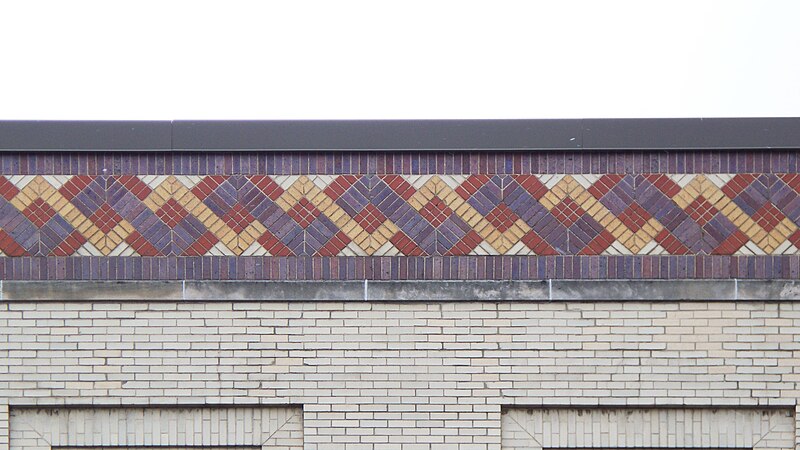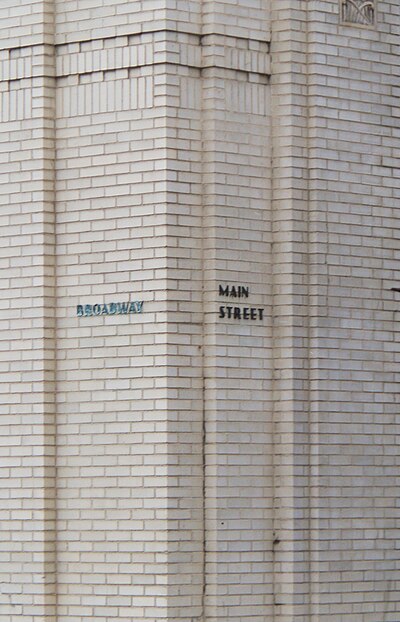
Press C. Dowler was the architect of the school, and may have designed the urns as well.

Press C. Dowler was the architect of the school, and may have designed the urns as well.

Press C. Dowler, who designed several other schools and public buildings in the Chartiers Valley, was the architect of this school, which was built in 1914. It is no longer in use, but the building is in good shape.




Throughout his long career, which went from Romanesque through classical through Art Deco to modernism, Dowler used simple materials to weave interesting geometric decorations.


You could count on architect Press C. Dowler for the bankiest-looking banks. The correct Ionic front of this one looks almost exactly the way he drew it, as we can see from the architect’s rendering that was published in the Press on February 8, 1931.

It seems to old Pa Pitt that the mark of a Dowler bank is correct classical detail combined with a lack of fussiness. There is never too much detail. But he takes the details seriously. In other buildings he was already adopting Art Deco and modernist styles, but a bank needed to look traditional and timeless—especially in the Depression. For other Dowler bank designs, see the Coraopolis Savings and Trust Company and the Braddock National Bank.

Another look at the Fifth Avenue façade of this very respectable bank building, designed by Press C. Dowler and opened in 1921.
More pictures of the Coraopolis Savings and Trust Company building.

Dowler & Dowler, father-and-son architects, designed this building for the Bell System’s western headquarters in Pennsylvania. We have seen the building from this angle before, but we have not seen it with a bus coming toward you, which is always an improvement.


The Stanwix Street front has a Miesian colonnaded porch, with a cheerful abstract mosaic ceiling.

Those cheerful square polka dots also show up in other parts of the building.

The cornerstone, with its late-Art-Deco lettering and date.

The Bell System emblem.
More pictures of the building, including the unique clock and globe (unfortunately out of order).

Still in use, with modern additions, as Crafton Elementary School, this Jacobean palace was built in 1913. The architect was Press C. Dowler, already well into a career that would last another half-century. His assignment here seems to have been to make up in spectacle for what the little borough’s high school lacked in size, and he came through with the goods, festooning the building with crenellations and terra-cotta ornamentation. But although the decoration may be a bit extravagant, it is done with good taste, making a balanced composition outlined by the sharp contrast between the red brick and the white trim.

The original school had two identical entrances—probably, as was common in those days, one for boys and one for girls.








Press C. Dowler, prolific architect of schools, banks, and telephone exchanges, designed this solid-looking classical bank, and the Pittsburgh Daily Post tells us that the opening (October 10, 1921) was a gala occasion.


The building no longer houses a bank, but almost nothing about the exterior has changed since that opening day, except that the big windows may not originally have been filled in with glass block.

A look down the Mill Street side of the bank, with the Ohio Valley Trust Company building in the background.

Mill Street does not meet Fifth Avenue at exactly a right angle, which leaves room for this curious triangular pit with a basement entrance.

A lantern on the front of the building.

A picture on a sunny day.

A simple but pleasingly proportioned telephone exchange that was almost certainly designed by Press C. Dowler, who got all the telephone company’s local business in the Art Deco era.



Press C. Dowler was almost certainly the architect of this classic Art Deco telephone exchange, since he designed most of the buildings for Bell Telephone in our area during the Art Deco era.
The blankness of the first floor is probably original. As much of the switching equipment as possible was on the ground floor, because copper was expensive, and anything that shortened the distance that had to be cabled saved a lot of money.

The polychrome frieze is an unexpected flash of color on what is otherwise a monochrome building that makes its decorative statements with cleverly patterned brick, a few stone accents, and small terra-cotta ornaments.




It used to be usual for corner buildings to carry the names of the streets in lieu of street signs. It was already old-fashioned when this building went up, but who could resist those elegant Art Deco letters?

This splendid edifice cost about $100,000 when it was built in about 1905. The architects were McCollum & Dowler,1 and that Dowler is the young Press C. Dowler, who would practice architecture for two-thirds of a century and run through every style of his long lifetime, from Romanesque through Art Deco to uncompromising modernism. The building still stands today on Braddock Avenue, and the front still looks about the same.